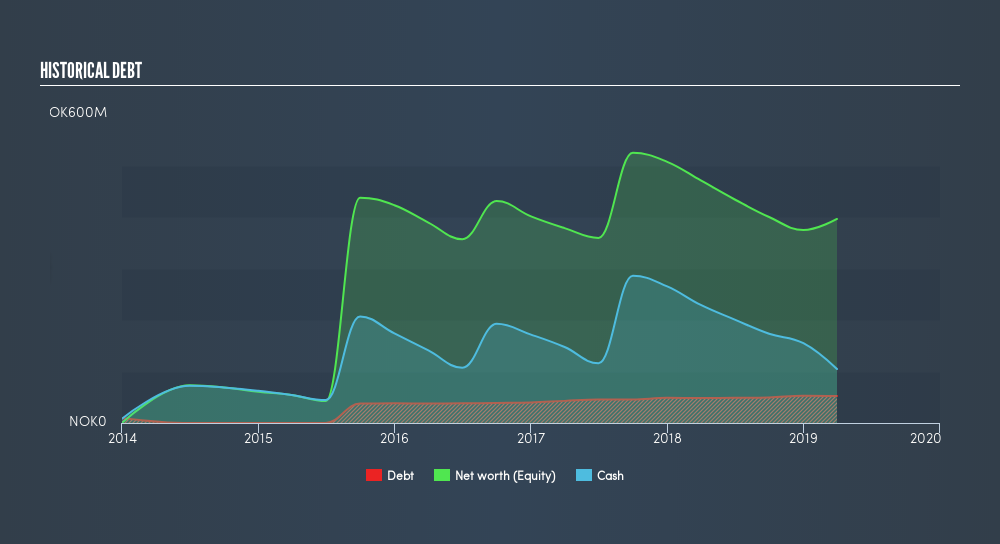Legendary fund manager Li Lu (who Charlie Munger backed) once said, 'The biggest investment risk is not the volatility of prices, but whether you will suffer a permanent loss of capital.' It's only natural to consider a company's balance sheet when you examine how risky it is, since debt is often involved when a business collapses. As with many other companies Targovax ASA (OB:TRVX) makes use of debt. But should shareholders be worried about its use of debt?
When Is Debt Dangerous?
Generally speaking, debt only becomes a real problem when a company can't easily pay it off, either by raising capital or with its own cash flow. Part and parcel of capitalism is the process of 'creative destruction' where failed businesses are mercilessly liquidated by their bankers. However, a more frequent (but still costly) occurrence is where a company must issue shares at bargain-basement prices, permanently diluting shareholders, just to shore up its balance sheet. Of course, the upside of debt is that it often represents cheap capital, especially when it replaces dilution in a company with the ability to reinvest at high rates of return. The first thing to do when considering how much debt a business uses is to look at its cash and debt together.
Check out our latest analysis for Targovax
What Is Targovax's Debt?
You can click the graphic below for the historical numbers, but it shows that as of March 2019 Targovax had kr52.4m of debt, an increase on kr48.7m, over one year. However, it does have kr104.9m in cash offsetting this, leading to net cash of kr52.5m.

A Look At Targovax's Liabilities
According to the last reported balance sheet, Targovax had liabilities of kr63.0m due within 12 months, and liabilities of kr103.4m due beyond 12 months. Offsetting this, it had kr104.9m in cash and kr91.5m in receivables that were due within 12 months. So it actually has kr30.0m more liquid assets than total liabilities.
This short term liquidity is a sign that Targovax could probably pay off its debt with ease, as its balance sheet is far from stretched. Simply put, the fact that Targovax has more cash than debt is arguably a good indication that it can manage its debt safely. When analysing debt levels, the balance sheet is the obvious place to start. But it is future earnings, more than anything, that will determine Targovax's ability to maintain a healthy balance sheet going forward. So if you want to see what the professionals think, you might find this free report on analyst profit forecasts to be interesting.
Since Targovax doesn't have significant operating revenue, shareholders may be hoping it comes up with a great new product, before it runs out of money.
So How Risky Is Targovax?
By their very nature companies that are losing money are more risky than those with a long history of profitability. And the fact is that over the last twelve months Targovax lost money at the earnings before interest and tax (EBIT) line. Indeed, in that time it burnt through kr125m of cash and made a loss of kr153m. With only kr105m on the balance sheet, it would appear that its going to need to raise capital again soon. Overall, its balance sheet doesn't seem overly risky, at the moment, but we're always cautious until we see the positive free cash flow. When I consider a company to be a bit risky, I think it is responsible to check out whether insiders have been reporting any share sales. Luckily, you can click here ito see our graphic depicting Targovax insider transactions.
If you're interested in investing in businesses that can grow profits without the burden of debt, then check out this free list of growing businesses that have net cash on the balance sheet.
We aim to bring you long-term focused research analysis driven by fundamental data. Note that our analysis may not factor in the latest price-sensitive company announcements or qualitative material.
If you spot an error that warrants correction, please contact the editor at editorial-team@simplywallst.com. This article by Simply Wall St is general in nature. It does not constitute a recommendation to buy or sell any stock, and does not take account of your objectives, or your financial situation. Simply Wall St has no position in the stocks mentioned. Thank you for reading.
About OB:CRNA
Circio Holding
A biotechnology company, develops novel circular RNA and immunotherapy medicines.
Slight risk with imperfect balance sheet.
Market Insights
Community Narratives



